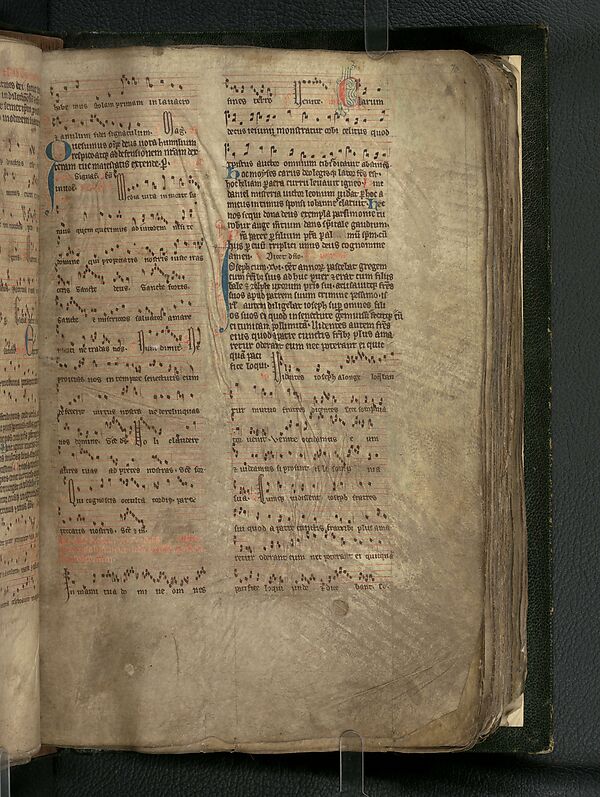Showing Browse Resources: 1 - 9 of 9
'Bohun Psalter' made in England in the late 14th-century for Eleanor de Bohun, Duchess of Gloucester.
Item
Identifier: Adv.MS.18.6.5
Scope and Contents
The contents of the manuscript are as follows:(i) Calendar in black, blue and red (folio 3). Entries in red include Saints Edward (18 March) and Dunstan (19 May), `Depositio sancti Augustini` (26 May), ordination of St Gregory (3 September) and translations of Saints Hugh (6 October) and Edward (13 October).(ii) Office of the Blessed Virgin Mary for Advent (folio 9) and from Christmas to the Purification (folio 11 verso).(iii) Confession, attributed in the...
Dates:
Late 14th century.
Calendar from a 14th-century Dominican liturgical book produced in southern Germany.
Item
Identifier: Adv.MS.81.4.20
Scope and Contents
The entries are in black and red, with one (translatio Marie Magdalene, March 19) in blue. Among those in red are: Dorothea (February 7), Runegund (March 3), George the Martyr (April 23), Peter (April 29: ‘ord(in)is n(ostri)’), Walburga (May 1), translatio beati Dominici (May 24), Henry (July 13), Dominic (August 5: ‘co(n)fess(oris) p(at)ris n(ost)ri’), Laurence (August 10), Sebaldus (August 19), Abbot Giles (September 1), Martin of Tours (November 11), Elisabeth of Hungary (November 19),...
Dates:
14th century.
Calendar from a 14th-century liturgical work from Germany.
Item
Identifier: Adv.MS.81.4.21
Scope and Contents
The entries are in black and red. Among those in red are: Peter (April 29), Petronella (May 31), Dominic (August 5 ‘p(at)ris n(ost)ri`), Augustine (August 28), and Nicholas (December 6). There are several later additions, including: Gertrude (March 17), Adalbert (April 23), Erasmus (June 2), Procopius (July 11), Anne (July 26), Martha (July 27), Barbara (December 4). Othmar (November 15) and Conrad (November 26) are deleted.The calendar is from a Dominican house, perhaps a...
Dates:
14th century.
Calendar of Holyrood Abbey: a bifolium containing the entries for July to October.
Item
Identifier: MS.5048
Scope and Contents
The entries are written in red, blue, green, and black. There are several additions and deletions in later hands, and a sixteenth-century marginal note concerning writs of property.
Dates:
13th century.
Fragments of at least 7 and perhaps 8 manuscripts on medicine and astrology, some, if not all, English.
Series
Identifier: Adv.MS.23.7.11A-H; (former binding)
Scope and Contents
A and E may be in the same hand and from the same manuscript.
Dates:
14th century-15th century.

Late 13th-century manuscript known as the 'Sprouston Breviary'.
Item
Identifier: Adv.MS.18.2.13B
Scope and Contents
This manuscript was produced in Scotland in the late 13th century, probably sometime between 1285 and 1300 according to Hair and Knott. Borland, Frere and McRoberts have suggested that it may be of the early 14th century, but most scholars agree that it was written sometime around 1300. The manuscript contains musical services as well as the text of Church services according to the Use of Sarum. The work is written in littera textualis in double columns of unequal length....
Dates:
Late 13th century.
Manuscript known as the 'Herdmanstoun Antiphonal', or 'Herdmanstoun Breviary'.
Item
Identifier: Adv.MS.18.2.13A
Scope and Contents
Manuscript known traditionally as the Herdmanstoun Breviary, but more correctly described as an Antiphonal. It was written in the north of England, possibly Northumberland, but later taken to Scotland and altered. It has been suggested by Höhler that the manuscript was possibly written for the college of canons founded at Chester-le-Street by Bishop Anthony Bek of Durham. Bannister speculates that the volume may have been brought to Scotland during the reign of David II (1329-1371). ...
Dates:
Circa 1300
Manuscript of 'Oculus Sacerdotis' by William of Pagula.
File
Identifier: Adv.MS.18.3.6
Scope and Contents
The text (folio 12) contains the three sections of the treatise, ‘Pars Oculi`, `Dextera Pars` and `Sinistra Pars`, but cap. 26 to the end of the `Sinistra Pars` is missing. The text is preceded by:(i) Four short works on diet and blood-letting in English, beginning ‘Here seyth galian ye leche and thecheth of metes and drinkes’. At the end is a rubric ‘Secundum Robertum[?] Grant de Everton’ (folio 1 verso).(ii) Remarks on the qualities of the Virgin...
Dates:
14th century.
Perth Psalter, containing calendar, psalter, canticles, and litany.
Item
Identifier: MS.652
Scope and Contents
Referred to as the Perth Psalter from the entry in the calendar on 3rd September, ‘Dedicacio ecclesie de Perth’.The calendar and the litany are based on the use of Sarum, with additional entries for Scottish Saints. There are several illuminated capitals, four of the larger of these are accompanied by full-page borders of conventional foliage. Accompanying the manuscript is a list of additions to the calendar in a later cursive hand which were brought out by chemical action by F...
Dates:
Late 15th century.
